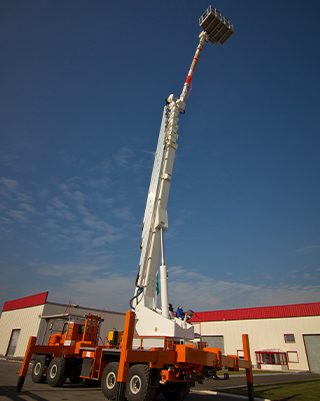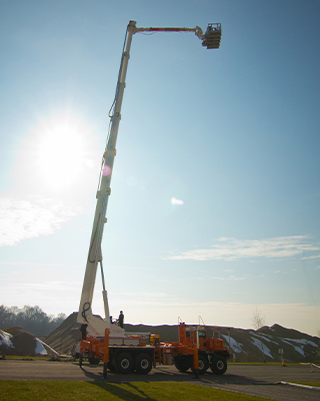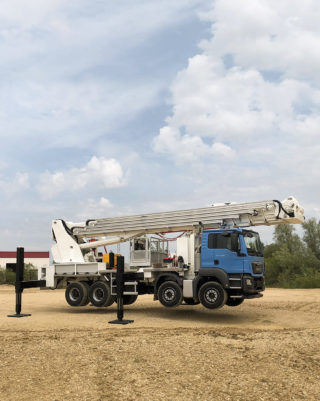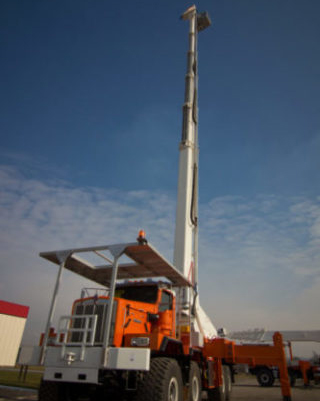Aerial Platforms
for Live Line Working
The best live line Aerial Platforms for working with ultimate bare hand method
In order to provide safety, effectiveness and freedom of movement during your live-line maintenance we have designed the most efficient hydraulic live line aerial platforms. Due to their unique and patented technologies, our series of live line aerial platforms, the chance to repair electrical wires, replacing insulators, dead end insulator strings retrofit, jumpers connection, connectors or lugs clamping in good conditions are guaranteed.
The E series of insulator aerial platforms provide you live working with ultimate bare hand method at 500 kV EHV transmission lines. With the E series telescopic articulated boom you’ll reach working heights of up to 67m. Our live line aerial platforms designed for Distribution lines are fully compliant with IEC1057; thanks to our unique design of foam-filled insulated boom.
30m insulated aerial lift E30P
30m Aerial platform insulated E30P Our E30P Hydraulic Insulating Access Platforms takes advantage of unique EGI Type II foam filled technology: epoxyde-resin reinforced by glass fiber tube filled by high density polyurethane foam (closed particles) for live [...]
37.80m Insulated Aerial Lift E38P
37.80m Aerial Platform Insulated E38P For live line hot sticks and bare hands operations up to 500kV Our Hydraulic Insulating Access Platforms takes advantage of unique EGI Type II foam filled technology: epoxyde-resin reinforced by glass fiber [...]
50m Insulated Aerial Lift E51P
50m Aerial Platform Insulated E51P Rated voltage 500kV (phase-phase) high voltage networks Our Hydraulic Insulating Access Platforms takes advantage of unique EGI Foam-Filled Boom Technology Type III, that provides world’s best dielectric protection. They are equipped with Last [...]
67m Insulated Aerial Lift E67P
67m Aerial Platform Insulated E67P IEC - E67P Hydraulic Aerial Platform Hydraulic Aerial Platform Rated voltage 500kV (phase-phase) high voltage networks EGI unique Technology and Design combine to provide the World’s Best Hydraulic Aerial Platforms for Live [...]
AERIAL PLATFORMS FOR ELECTRICAL DISTRIBUTION
The new range of insulated lifts for electrical distribution up to 46 kV
The KI series of hydraulic aerial platforms is designed for electrical distribution rating up to 46 kV. Why are they special? Mounted on vans or chassis these boom lifts are covered with insulating resin and fibre glass. If you choose the van range you can reach a working height of 12,5 metres to 14 metres. If you choose the chassis one, you will reach a working height of 12,50 metres to 18,20 metres.
Live-line working is a field of electrical engineering and alternatively known as hotline maintenance, pertains to the upkeep and servicing of electrical systems and components, frequently operating under high voltage, while they remain powered or energized. This approach, despite posing greater risks to personnel compared to methods involving powered-down equipment, is strategically employed in the electric power distribution sector. The primary aim is to circumvent the considerable inconvenience and substantial financial implications that would result from shutting down power supply to consumers for routine maintenance activities on transmission lines and other related apparatus.
The genesis of live-line working techniques dates back to the early 20th century. Over time, these techniques, along with the equipment used, have undergone significant advancements to accommodate the challenges posed by progressively higher voltage levels. Notably, in the 1960s, experimental methods were developed in laboratory settings, enabling field personnel to engage directly with high voltage lines without jeopardizing safety. These methodologies have been refined and adapted for application even at the most elevated levels of transmission voltages, ensuring the maintenance work is conducted effectively while prioritizing safety.
Backgrounds
Generally, it is not feasible to ascertain through visual inspection alone whether electrical equipment is energized. Consequently, there are instances where it becomes essential to perform maintenance or repairs on circuits while they remain operational. Moreover, when dealing with high-voltage scenarios, direct contact with charged equipment is not a prerequisite for receiving an electric shock. This is due to the potential of an electrical arc to bridge the gap between the equipment and a tool or a part of the human body.
Furthermore, materials traditionally regarded as superior insulators, such as rubber, are not immune to electrical failure, especially under high-voltage conditions. The inherent properties of these materials, while effective under certain circumstances, may not provide sufficient protection against the intense electrical forces present in high-voltage environments. This underscores the importance of advanced safety measures and specialized equipment in handling and maintaining high-voltage electrical systems.
Live-Line working methods
Generally, there are three primary methods of live-line working, each designed to mitigate the significant risks associated with this type of work. These methods all share the common goal of preventing the flow of electrical current from live equipment through the worker.








